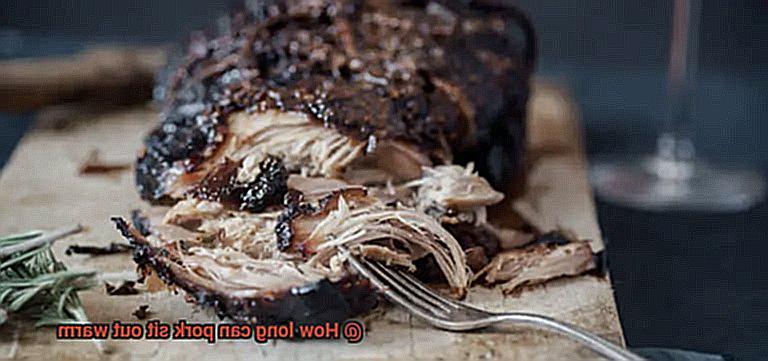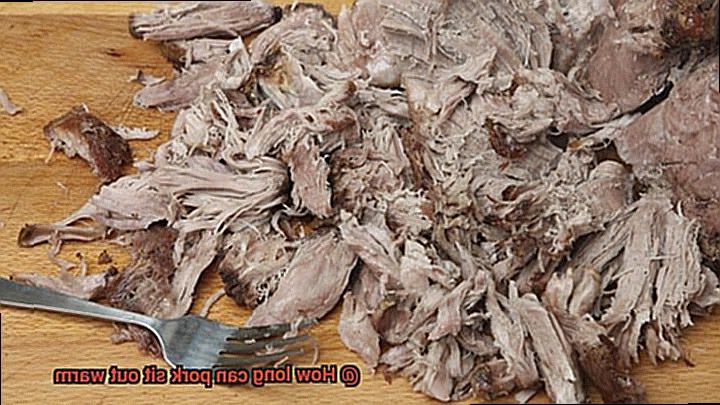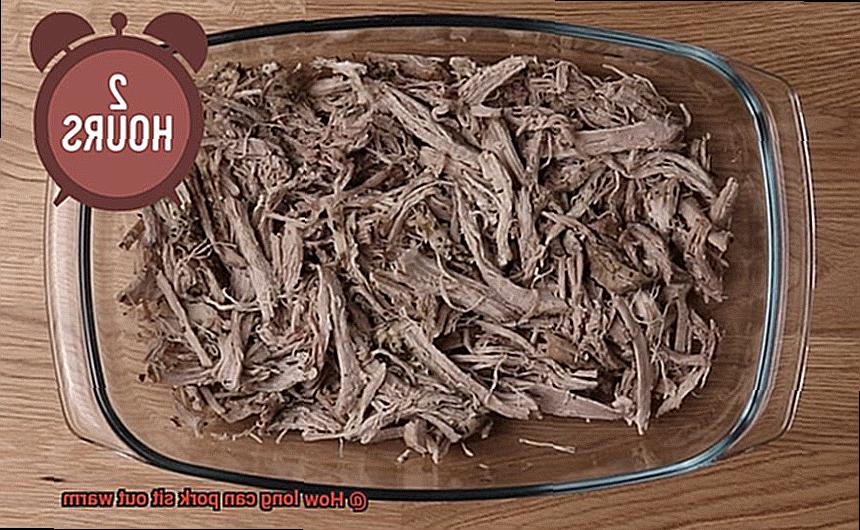Do you savor the succulent taste of pork, but often find yourself confused about how to store it correctly? Have you ever been in a situation where you left your pork out at room temperature for a bit too long and wondered if it was still safe to consume?
Well, fret not. We have all the answers you need. Pork is a versatile meat that can be cooked in various ways, but proper storage is crucial to avoid food poisoning. In this article, we’ll take a deep dive into the world of pork storage and answer the question that’s been on your mind: how long can pork sit out warm?
We’ll explore different factors that affect pork’s freshness and longevity, such as temperature, humidity, and exposure to air. Additionally, we’ll discuss how to properly store pork in the fridge or freezer to maximize its shelf life.
Whether you’re an experienced cook or new to cooking with pork, this article is for you. So sit back, relax and get ready to learn everything there is to know about how long pork can sit out warm without compromising your health or taste buds.
Contents
What is the Temperature Danger Zone for Food?
When it comes to food safety, we cannot stress enough the importance of proper handling and storage of all food items, especially meat. Pork, in particular, requires extra care as it is a sensitive meat that can easily become a breeding ground for harmful bacteria that cause foodborne illnesses. So, how long can pork sit out at room temperature before it becomes unsafe to eat? The answer lies in understanding the Temperature Danger Zone (TDZ) for food.

The TDZ is a critical range of temperatures between 40°F and 140°F, where bacteria grow and multiply rapidly. When food is left at room temperature, it falls within the TDZ, providing an ideal environment for bacteria to thrive. Within just a few hours, the number of bacteria can increase exponentially, putting anyone who consumes the food at risk of foodborne illness.
It’s important to note that not all bacteria are harmful. However, some strains such as Salmonella, E. coli, and Listeria can cause severe illness or even death when consumed in contaminated food. Therefore, it’s crucial to ensure that perishable foods like pork are stored and handled correctly to minimize the risk of bacterial growth.

Perishable food items like pork should not be left at room temperature for more than two hours. After this time frame, the risk of bacterial growth increases significantly, and the pork should be discarded. When the temperature is above 90°F, such as during hot summer weather or in a warm kitchen, the maximum time that pork can be left out reduces to one hour.
It’s also essential to note that cooked pork should not be left out at room temperature for more than two hours. If you plan on serving cooked pork at a party or buffet, it should be kept hot at a temperature of 140°F or higher using chafing dishes or warming trays.
Proper handling and storage of pork are essential for food safety and preventing foodborne illnesses. Pork should be kept below 40°F in the refrigerator or freezer until it’s ready to be cooked. Once cooked, it should be held at a temperature above 140°F or kept hot until it’s served.
How Long Can Pork Sit Out at Room Temperature?
Pork is a beloved meat all around the world, but it’s important to know how to store and handle it correctly to avoid foodborne illnesses. Bacterial growth can occur if pork is left at room temperature for too long, which can lead to serious health issues. So, the question remains: how long can pork sit out at room temperature before it becomes unsafe to consume?
According to the United States Department of Agriculture (USDA), pork should not be left at room temperature for more than two hours. This is because bacteria thrives in the “danger zone” between 40°F and 140°F. If the temperature of the pork rises above 140°F, then bacteria will begin to die off. However, if it remains between 40°F and 140°F for too long, then bacteria can grow to dangerous levels.
It’s essential to note that this two-hour rule applies to both cooked and uncooked pork. If you leave cooked pork out at room temperature for more than two hours, harmful bacteria can multiply on the surface of the meat. Similarly, if you leave raw pork out at room temperature for more than two hours before cooking, bacteria can start growing on it.
To ensure that your pork stays safe to eat, always follow proper food safety practices. Keep cooked pork in a warm oven (below 140°F) or in a chafing dish or slow cooker until you’re ready to serve it. If you have leftovers, store them in the refrigerator within two hours of cooking and consume them within three to four days. When storing raw pork, keep it in the refrigerator at a temperature below 40°F until you’re ready to cook it.
What Factors Increase the Risk of Bacterial Growth?
Pork is a scrumptious meat enjoyed by people worldwide, but if not stored and handled properly, it can quickly turn into a breeding ground for harmful bacteria.
Bacteria are notorious for thriving in warm, moist environments, making pork left out at room temperature a potential health hazard. Temperature is one of the main factors that increase the risk of bacterial growth. The ideal temperature range for bacterial growth is between 40°F and 140°F – commonly referred to as the “danger zone.” If pork is left out in a warm room with temperatures above 40°F for an extended period of time, it becomes more susceptible to bacterial growth.

The length of time that pork sits out also contributes to the risk of bacterial growth. The more time pork spends outside the refrigerator or freezer, the more time bacteria have to multiply and spread. To avoid this, it’s essential to refrigerate or freeze pork immediately after cooking or purchasing it.
Aside from temperature and time, moisture on the surface of the pork can also increase the risk of bacterial growth. Bacteria thrive in moist environments and can multiply rapidly if given the chance. Thus, it’s crucial to pat pork dry before cooking and store it in dry surroundings post-cooking.
Poor sanitation practices during preparation or handling, improper storage temperatures during transportation or storage, and cross-contamination from other foods or surfaces are additional factors that can increase the risk of bacterial growth. Following proper food safety guidelines at all times is crucial to minimize the risk of bacterial contamination and ensure safe consumption of pork.
What About Cooked Pork?
Whether it’s leftovers or a yummy dish from your favorite restaurant, it’s crucial to keep it safe from harmful bacteria.
Don’t leave cooked pork out at room temperature for more than two hours. If it’s hotter than 90°F (32°C), then you only have one hour. Bacteria thrive in warm temperatures, and the longer food sits out, the more chances they have to multiply.
But reheating cooked pork won’t eliminate all bacteria that grew while it was left out. So refrigerate or freeze your leftovers ASAP. Cooked pork can safely chill in the refrigerator for four days or in the freezer for six months.
Before consuming leftover pork, make sure it reaches an internal temperature of 165°F (74°C) when reheated. This ensures any remaining bacteria are killed and the pork is safe to eat. Please don’t leave cooked pork on a buffet table or in a slow cooker for long periods, as this increases the risk of foodborne illness.
Tips for Keeping Pork Safely
Pork is a tasty and versatile meat that can be used in a variety of dishes, from savory pulled pork to juicy pork chops. However, it’s important to handle and store it properly to prevent the growth of harmful bacteria that can cause foodborne illness. Here are five tips for keeping pork safely:

Keep Pork at a Safe Temperature
The first and most crucial tip for keeping pork safely is to store it at the right temperature. Always keep pork in the refrigerator or freezer until ready to use, and make sure it is stored at a temperature of 40°F or below. If you’re transporting pork, use a cooler with ice packs to maintain a safe temperature.
Cook Pork Thoroughly
Cooking pork to the right temperature is essential for killing any harmful bacteria that may be present. Use a meat thermometer to ensure that pork reaches an internal temperature of 145°F. Once cooked, pork should be consumed or refrigerated within two hours. Leaving cooked pork out at room temperature for longer than two hours can cause bacteria to grow, making it no longer safe to eat.
Handle Raw Pork with Care
Proper hygiene is crucial when handling raw pork. Always wash your hands thoroughly before and after handling pork, as well as any utensils or surfaces that come into contact with the raw meat. This will help prevent the spread of harmful bacteria.
Keep Raw Pork Separate
When storing and preparing raw pork, it’s important to keep it separate from other foods to avoid cross-contamination. Use separate cutting boards and utensils for raw meat, and make sure to wash them thoroughly before using them for other foods.
Use or Freeze Raw Pork Within Three to Five Days
To ensure maximum freshness and safety, use or freeze raw pork within three to five days of purchase. If you freeze pork, make sure it is properly wrapped and labeled with the date it was frozen. When thawing frozen pork, do so in the refrigerator, in cold water, or in the microwave using a defrost setting.
F19_WJMcgkQ” >
Conclusion
In conclusion, pork is a delicious and versatile protein that can be enjoyed in many different ways. However, it’s crucial to handle and store it properly to avoid the risk of food poisoning. Leaving pork at room temperature for more than two hours is a recipe for disaster as it falls within the Temperature Danger Zone (TDZ), where bacteria thrive and multiply rapidly.
To keep your pork fresh and safe to eat, it’s essential to store it below 40°F in the refrigerator or freezer until you’re ready to cook. After cooking, make sure you keep the cooked pork at a temperature above 140°F or keep it hot until serving time. Failure to follow these guidelines could result in serious health consequences.
There are several factors that can increase the risk of bacterial growth on pork, including temperature, time, moisture, poor sanitation practices during preparation or handling, improper storage temperatures during transportation or storage, and cross-contamination from other foods or surfaces. By following proper food safety guidelines at all times and being mindful of these risk factors, you can minimize the chances of getting sick from eating pork.
Here are some tips for safely handling and storing pork:
- Store raw pork at a safe temperature below 40°F.
- Cook pork thoroughly using a meat thermometer to ensure it reaches an internal temperature of 145°F.
- Handle raw pork with care by washing your hands and utensils thoroughly before and after use.
- Keep raw pork separate from other foods to prevent cross-contamination.
- Use or freeze raw pork within three to five days of purchase.
By following these tips and guidelines, you can enjoy the succulent taste of pork without compromising your health or taste buds.






